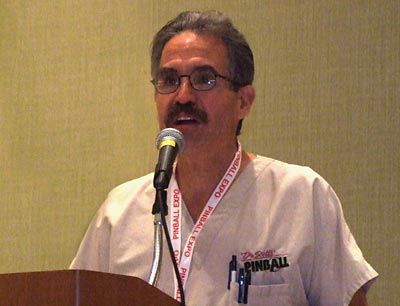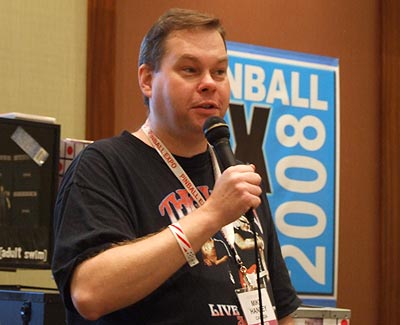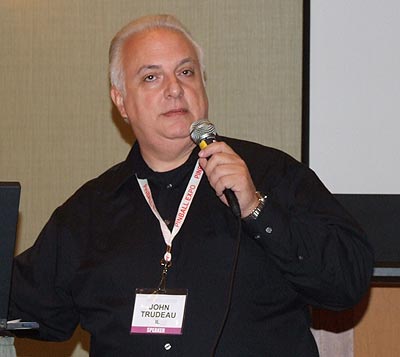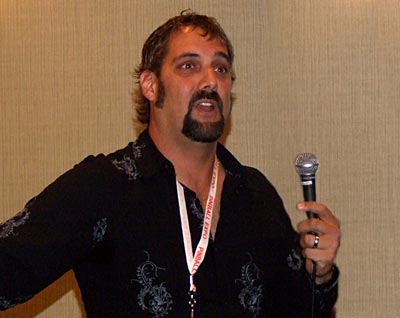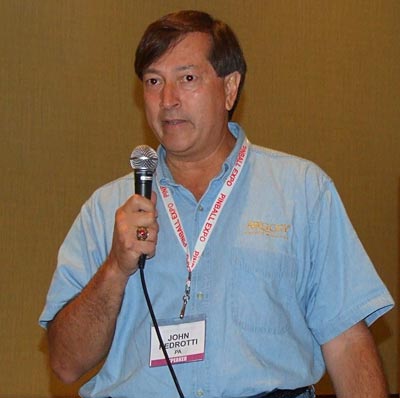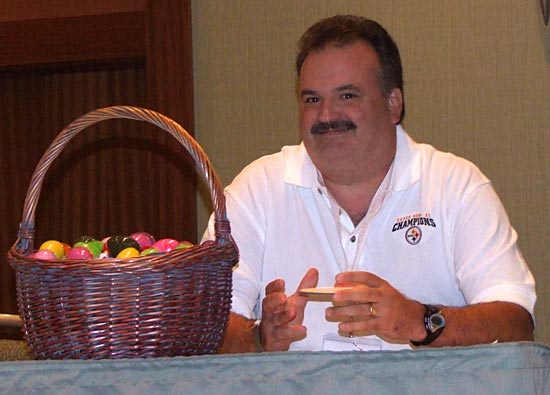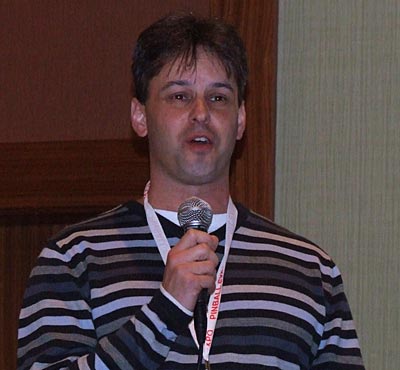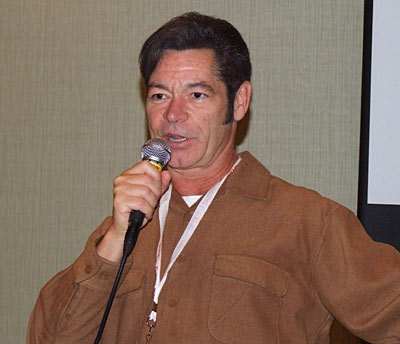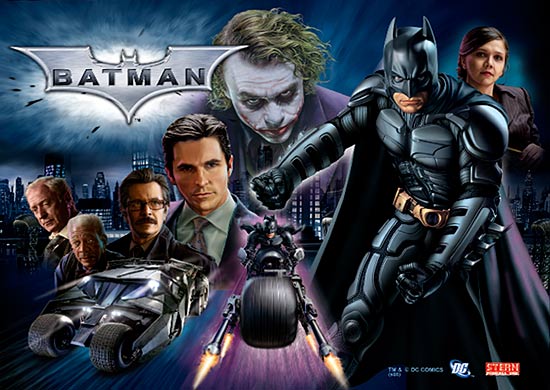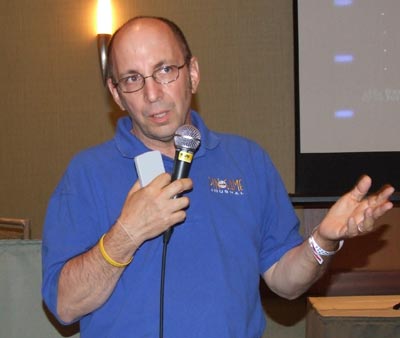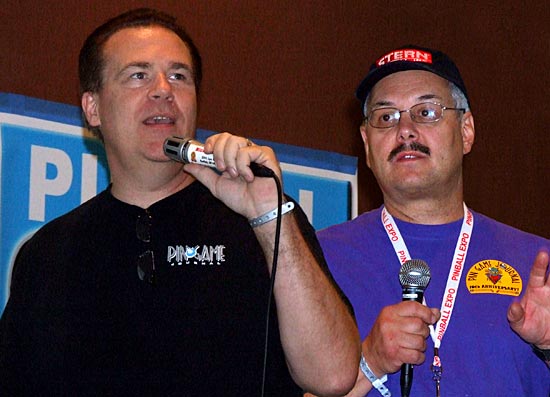| PINBALL EXPO 2008 |
| Date: 1st - 5th October 2008. Welcome back to the second part of our coverage of the seminars at Pinball Expo 2008. In this section we'll look at the talks given on Friday's which is only full day of seminars, starting at 8:45 in the morning and continuing until about 6pm with an hour break for lunch. Friday was also the day for the ExpoBrawl team tournament, so anyone playing in that will have missed many of these seminars. We hope they find this a useful service to catch up on those presentations. You may find some of these presentations say "coming soon". That's because each seminar takes around 4 hours to edit, process and create the accompanying article with pictures. The initial 4 took 16 hours and there are a further 5 to go, so rather than make you wait until another 20 hours can be found to complete the whole lot, we've put the first batch up here and will update this page when each seminar's report is finished. Before the first of Friday's talks, Rob Berk and Mike Pacak - Pinball Expo's organisers - spoke to the early morning crowd to thank them for coming, detailing a few of the events coming up over the new few days and to give thanks to all the seminar speakers.
Following Rob and Mike, the first of today's seminars began and as usual in the early morning slot we find "Dr Scott" Sheridan and his colleagues.
Scott Sheridan has been running his "Dr Scott's" Pinball Store out of Maumee, near Teledo, Ohio for 15 years.
One of the strangest games Scott had bought was on display in the main hall - a pinball game called First Toon To The Moon. Scott related how he had received a call offering the game for sale and had gone to pick it up only to discover just how huge and heavy this two player game really was.
Scott went through a short list of must-have items to take on a service call before hading over to Chris who continued the theme by looking at some of the solvents and solutions they use, highlighting both their uses and the problems you can find when using them on coin-operated machines.
Chris went through some of his favourite troubleshooting tips before moving on to the use of a tumbler to clean up parts and how to make sure the ball is in good condition to avoid damaging the playfield. They concluded by talking about the current state of the market for games, which they said "sucks" at the moment. But they had a positive attitude and Scott emphasised that he's only in it for fun and not to make money - a sentiment echoed by Chris. Get the Flash Player to hear this audio clip.
Want to download this seminar? Click here to play the MP3 version or right click to save it.
9:15am Pimp Your Zizzle - Mike Hanley Mike lives in Toronto where he houses his large pinball collection in a hands-on museum he calls The Church Of The Silver Ball.
When his friend John Popadiuk designed the first Zizzle machine, Mike thought this not only fulfilled that need but provided the platform for development of different themes beyond Zizzle's Marvel Heroes and Pirates Of The Caribbean themes. His friend Sean O'Neil agreed and they both set about modifying their Zizzle games and turning them into very different machines. Mike made his into a Gottlieb Kings & Queens while Sean themed his around the Adult Swim animated series Metalocalypse.
Sean explained how he saw the Zizzle game and found an opportunity to combine his loves of pinball and heavy metal music through the Metalocalypse theme. he moved switches and various playfield features around to fit his design and incorporated a lower level playfield. In all he thinks he spent 70-80 hours working on the game but insisted it wasn't an expensive conversion with the wooden cabinet panels being one of the most costly parts at about $18. He did admit to splashing out on the optional add-ons such as the DVD player and the limited edition toy models which together cost more than the rest of the game.
Sean also cautioned anyone else following the same path to be aware that the games are made in the Far East and therefore use metric-sized parts, not the imperial sizes found on most full-sized machines. Mike said they have had about 25 Zizzle machines so far which they bought at various prices both new and second-hand. He advised anyone who always wanted to create their own machine but lacked the resources, skills and space to realise it to try with a Zizzle game. Get the Flash Player to hear this audio clip.
Want to download this seminar? Click here to play the MP3 version or right click to save it.
9:45am Games That Were Never Produced - John Trudeau John is the well known pinball designer of games such as Bride of Pinbot and Creature From The Black Lagoon who also goes under the pseudonym of Dr Flash.
Starting around 1980 while he was working at Game Plan, John began with a cocktail pinball game design called Kings Of The Road. Although this design was not used, he did go on to produce cocktail-format games such as Night Moves and Caribbean Cruise.
When John moved to Gottlieb he created a multi-level game called Magic which would use mirrors to increase the visual depth of the game and show the action on a sub-level mini-playfield.
When Williams came out with a series of games with ramps and upper playfields, Gottlieb copied the idea in their games which led to a number of existing single-level designs being scrapped.
John also produced his modern-day tribute to the bingo game. Using standard sized pinballs, the game was called Sevens and the aim was to score a total of seven as the ball trickled its way down to the bottom.
John was unsure why this game was not produced but suspected it may have something to do with Bingo's gambling connotations, of which Gottlieb were famously wary. When he moved to Williams, John said he had more time and resources to develop his games and none of the designs were rejected. The only games not produced were the two he was working on when the cut-backs resulted in his job disappearing. The first game was Aces: Escape From The Bermuda Triangle while the second was The Beatles, using a novel cabinet with an upper playfield reflected onto the main playfield, the shape of which would later become rather more familiar.
After leaving Williams, John worked briefly for ICE in Buffalo, New York, designing a Caddy Shack game which was to be their first venture into pinball. Unfortunately though, ICE changed their mind and closed down all pinball development before the game got into production. Get the Flash Player to hear this audio clip.
Want to download this seminar? Click here to play the MP3 version or right click to save it.
Mark Patzke is the President and Owner of Multi Products, a company which has been making motors and gearboxes for numerous applications - including pinball - for over 50 years.
Mark then covered the games in his personal collection before explaining how motors are designed and the materials used for the different uses within pinball games, from the 1950s through to the motors used in the new Batman model.
Mark said he can repair just about any of their motors if they are sent in. The company offers a fixed price repair service of $200 to repair the motor and replace any broken gears, although Mark was keen to ask people to remove as much of the mounting hardware and the driven device as possible before sending in a motor and/or gearbox. He also said if people contact him for information, it helps if they have the "Spec" number of the gearbox/motor which they can find stamped on the casing as shown in the image below.
Mark warned about the use of the wrong grease when lubricating a motor or gearbox drive train. Some greases can become much thicker over time which can lead to the gears or bearings seizing up. He recommends Magnalube grease which contains Teflon or or Slick One Lube which are designed for metal on metal contact without thickening. An alternative is 3-In-1 oil but not the regular red can. Instead, they make a blue can version especially for motors which Mark recommends. Never use WD-40 or kerosene since they will strip away the lubricants impregnated into the bearings which are needed for smooth operation. Get the Flash Player to hear this audio clip.
Want to download this seminar? Click here to play the MP3 version or right click to save it.
John and Jeff are collectors from Pittsburgh and their seminar would look at some of the hidden features (or "easter eggs") found in pinball machines.
They moved on by presenting easter eggs found in games such as The Addams Family, Attack From Mars, The Flintstones and Monster Bash as well as some hidden messages in newer Stern machines, although these were actually inserted for other reasons. The tradition of secret displays or animations was continued by Capcom with their Big Bang Bar game. Like its predecessors, the message was revealed using a secret combination of flipper button presses. John and Jeff concluded the pre-recorded segment by thanking Torbjörn Moolander who runs a website dedicated to revealing easter eggs, which provided the information for their seminar.
After the video presentation, Jeff passed around a basket of plastic easter eggs containing pieces of paper and those who picked ones containing green paper won a prize from a selection on an adjacent table which included t-shirts, plastic parts and translites. Get the Flash Player to hear this audio clip.
Want to download this seminar? Click here to play the MP3 version or right click to save it.
David helps run Bumper Action Amusements in Melbourne as its National Sales Manager and he came to Pinball Expo to talk about the pinball scene in Australia and what Bumper Action does to promote the game to home buyers.
After taking several management jobs with other companies, David joined Bumper Action in 1999 with a view to getting part-time work repairing some of their many electro-mechanical machines. Instead he was offered the post of Operations Manager which he accepted. He spoke about how the Bumper Action of today is very different from the company when he joined and illustrated his point with some pictures of how the showroom looks now.
When he joined, the company - like the amusement industry in general - was in a sorry state. Operators were closing down and sales of machines and parts declined accordingly. The company's owner, Del Reiss and David decided the only potential growth area was in home sales, since many people would like to own a pinball machine or other amusement game, but had no idea how to go about obtaining one. They tried first with a series of widely-publicised auctions which went well and produced many sales both on the day and subsequently until a competitor tried to compete with a similarly worded auction which confused the buying public. By linking up with local and national media, public awareness of the potential to own their own machine increased and sales followed. David said having a game in a person's home led to purchases from their friends who also wanted to have one. The demand, David explained, is mostly for '90s dot matrix machines with some alpha-numeric games also in demand along with a small number '70s games. There is little demand for electro-mechanical machines and what demand there is doesn't lead to anyone spending much money for them. The pinball market largely consists of the type of games you see above. Another way to promote pinball was through regular monthly meetings at the store where players could come to experience new machines and meet fellow owners in a family atmosphere with pizza and drinks provided. Pinball Faith was born. David said events like this, which bring not only older pinball players but the next generation of kids who would otherwise never experience pinball, was the way to save the game. Home pinball is where the sales are, now that operators and arcades have all but disappeared. As a distributor for Stern, David estimated the between 90% and 95% of all new Stern machines sold in Australia now go directly into people's homes, an extraordinary figure. After talking about the top prices they had sold games for, David present his list of the top 10 selling pinball machines for Bumper Action. He divided the list into two categories, one for pre-1990 machines and another for 1990 to the present.
David also produces a list of the machines which sell as soon as they arrive, what he called his "instant sellers".
The seminar concluded with a look at a new Australian arcade which was to feature a large collection of high-end pinball games, but which was ravaged by fire a few days before opening. Only the building was insured, not the games, but it is hoped they can be restored and the arcade rebuilt in the not-too-distant future. Get the Flash Player to hear this audio clip. Want to download this seminar? Click here to play the MP3 version or right click to save it.
2:00pm The Art of Star Trek & Star Wars - Kevin O'Connor Kevin is a well-known pinball artist who has created many classic playfield, backglass and cabinet art packages. In this seminar he spoke about his work on two particular sci-fi themes - Star Trek and Star Wars.
Kevin was approached by Joe Kaminkow to do another Star Trek at the start on the '90s, this time for Data East. The backglass featured a transporter which "beamed-down" the crew, so they were painted separately and overlayed onto an empty transporter room.
Kevin also managed to sneak himself onto the bridge next to Lieutenant Uhura.
Kevin then spoke about his work on the Pinball 2000 game Star Wars Episode 1, which began at the end of 1998. He said it was always exciting for any artist to work on Star Wars as an official designer. Lucasfilm provided Williams with lots of style guides - examples of how the characters, ships and other movie elements should (and should not) appear when drawn - as well as 3D models for use in the video rendering. From those guides, Kevin produced some initial drafts such as the ones shown below.
Some of these made it into the game while others went through various modifications. The "scene pod" at the top left later became Qui-Gon's holographic projector at the centre shot, where different modes could be selected and then started. The cabinet artwork was divided into two with one side having the good characters and the other side featuring the evil ones.
Kevin and game designer John Popadiuk played the parts of Darth Maul and Qui-Gon Jinn for the light saber fight scene. He said they spent several hours getting the choreography right and learning the moves with the help of a fellow Williams worker who knew some martial arts and could advise them on making it look realistic. Asked how his work had developed over the years, Kevin said he though he had moved away from the cartoon look of games such as Silverball Mania or Strikes and Spares, towards the more detailed and realistic style we see here. He also said he thought his art was less recognisable now, due to the need to adhere to style guides in order to get approval from licensors, which leads to a more generic and less individualistic look. He cited the work he did on Batman, where the main characters and props were supplied by Warner Bros and he had to paint the secondary characters played by Michael Caine, Morgan Freeman, Maggie Gyllenhaal and Gary Oldman to match, using photographs as reference.
Kevin said revisions to artwork are numerous and continue until the game hits the production line. The playfield is where the most changes take place due to alterations made to inserts or feature shots moving. He said he now produces playfield background artwork to cover the whole area and then overlays inserts, feature outlines and text labels so they can be easily moved or regrouped on the computer. Get the Flash Player to hear this audio clip. Want to download this seminar? Click here to play the MP3 version or right click to save it.
3:00pm More Pinball In The Media - Jim Schelberg Jim is Editor and Publisher of the Pingame Journal magazine and his seminar was used to show a collection of pinball-related video clips featured on some of the Pinball In The Media DVDs he sells.
Half way through the sequence of clips, Jim took time out to call Tim Arnold at his Pinball Hall Of Fame in Las Vegas to get the latest news on plans for the enterprise. Tim used to be a regular attendee at Pinball Expo but his commitment to the Hall Of Fame means it is not possible for him to leave Vegas and travel up to Chicago for the show. Instead, Tim spoke to the audience through Jim's phone and revealed his hopes to move to new, larger premises nearer the strip in Las Vegas. Although nothing had been confirmed, he was in negotiation over a property and has several others under consideration should that one not work out. A selection of George Carlin comedy moments - including one with a reference to pinball, naturally - rounded off the seminar. Due to the nature of Jim's presentation which is highly visual, the audio recording available below does not include most of the video clips presented at the seminar. Get the Flash Player to hear this audio clip. Want to download this seminar? Click here to play the MP3 version or right click to save it.
4:00pm We're Only In It For The Money - Don Caldwell & Mark Bakula Don and Mark are Pinball Expo regulars and Friday afternoon is their traditional slot in the schedule. In previous years they have talked about various different restoration techniques but this year they had a different angle on fixing games.
Their seminar this year looked at how best to buy an inexpensive game, fix it up and sell it so that you make money on the deal. Any restoration work would need to recover its cost in the final sale price. They chose as their game for this restoration, a Bally Eight Ball. There was a long list of faults and broken parts but the game could be fixed, made to look pretty good and then sold at a profit. Don examined each problem area in turn and then explained the solution they took, taking into account the time involved, the expenditure and the impact it will have to a potential buyer. At various points throughout their presentation, a multiple choice question was posed to a selected audience to see if they could predict what Mark and Don did to continue their restoration, while keeping the game within the time and monetary constraints. Those who guessed correctly received candy bars. At the end of the restoration, despite spending only a little over $100 on parts, they calculated what their time would be worth if the game sold for various different prices. In all cases, there was little financial incentive to spend the time fixing up the game. To close their presentation, they reprised their multiple choice pinball & rock 'n' roll quiz. Tickets were drawn and the holder could choose a pinball question about which of two games sold the most, or a rock 'n' roll question.
Winners could choose a prize from the assortment of pinball-related items on the table, losers got a consolation candy bar.
Get the Flash Player to hear this audio clip. Want to download this seminar? Click here to play the MP3 version or right click to save it.
|


